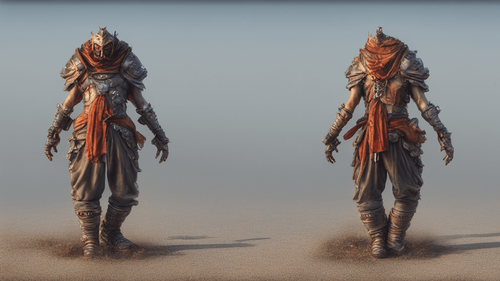
Introduction
In a world where innovation and technology constantly shape our lives, the realm of artificial intelligence (AI) has made remarkable strides. One such marvel is the captivating realm of Image Generation AI, a cutting-edge technology that's revolutionizing creativity and design. This article delves deep into the intricacies of Image Generation AI, exploring its potential, applications, and the groundbreaking impact it has on various industries.
Image Generation AI: Unveiling the Future of Creativity
As we stand on the cusp of a new era, Image Generation AI emerges as a beacon of ingenuity and artistic brilliance. Harnessing the power of machine learning and neural networks, this revolutionary technology transcends traditional design methods, enabling us to generate captivating and awe-inspiring visuals like never before.
The Inner Workings of Image Generation AI
At its core, Image Generation AI operates through the interplay of complex algorithms and immense computational power. By analyzing vast datasets and recognizing patterns, the AI learns to replicate and create images that captivate the human eye. It's a symphony of mathematics and creativity, resulting in a harmonious blend of art and science.
Applications Beyond Imagination
Image Generation AI isn't confined to a single domain; its applications span across a myriad of industries, each reaping the benefits of its unparalleled capabilities.
Visual Arts and Design
Image Generation AI empowers artists and designers to push the boundaries of their creativity. From generating stunning digital artwork to designing captivating logos, the AI serves as a limitless source of inspiration.
Fashion and Apparel
In the realm of fashion, Image Generation AI revolutionizes the design process. It can generate unique fabric patterns, innovative clothing designs, and even predict future fashion trends based on data analysis.
Film and Entertainment
Creating visually striking scenes and special effects is now more seamless with Image Generation AI. It assists in crafting lifelike CGI elements, enhancing the cinematic experience for audiences worldwide.
Video Games
The gaming industry thrives on innovation, and Image Generation AI fuels this innovation by creating lifelike characters, immersive environments, and dynamic textures that blur the line between reality and virtual worlds.
Medical Imaging
Image Generation AI plays a pivotal role in medical diagnostics by generating detailed and accurate images for diagnostic purposes. It aids healthcare professionals in making informed decisions and enhances patient care.
Architectural Marvels
Architects and urban planners leverage Image Generation AI to visualize architectural designs and urban landscapes. This technology provides a glimpse into the future of cities and structures, enabling informed urban development.
The Human-AI Collaboration: Fostering Creativity
Contrary to concerns about AI replacing human creativity, Image Generation AI serves as a catalyst for collaboration between man and machine. It amplifies human ingenuity, allowing artists, designers, and creators to explore uncharted territories of imagination.
Unlocking the Potential: Training Image Generation AI
The journey to mastery involves training Image Generation AI with diverse datasets and refining its algorithms. This process imbues the AI with the ability to comprehend the nuances of artistic styles and preferences, ultimately enhancing its creative output.
Addressing the Skepticism: Debunking Common Myths
Myth 1: AI Dilutes Human Creativity
Contrary to popular belief, Image Generation AI doesn't dilute human creativity; it enhances and magnifies it. By providing a new palette of tools and inspirations, it expands the horizons of artistic expression.
Myth 2: AI-Generated Art Lacks Emotion
AI-generated art isn't devoid of emotion; it encapsulates the essence of the data it learns from. Each stroke and pixel convey a story, a sentiment, and a piece of the human experience.
Myth 3: AI Jeopardizes Traditional Art Forms
Rather than endangering traditional art forms, Image Generation AI rejuvenates them. It infuses new life into age-old techniques, revitalizing art for modern audiences.
Frequently Asked Questions
How does Image Generation AI work?
Image Generation AI operates through intricate neural networks that analyze data patterns and generate images based on learned features.
Can AI-generated art be considered authentic?
Absolutely. While AI plays a role, the artistic direction, intent, and human touch contribute to the authenticity of the creation.
Is Image Generation AI only for professionals?
No, Image Generation AI tools are becoming more accessible to a broader audience, allowing enthusiasts and beginners to explore their creative potential.
Does AI completely replace traditional artistic methods?
No, AI complements traditional methods, offering new avenues for experimentation and inspiration.
What ethical considerations surround AI-generated content?
AI-generated content raises questions about copyright, authorship, and the value of human creativity, sparking essential discussions about the intersection of technology and art.
Can AI-generated designs be patented?
While the legal landscape is evolving, AI-generated designs may be eligible for protection under patent law if they meet the necessary criteria.
Conclusion
In the realm of creativity and design, Image Generation AI emerges as a powerful ally, redefining the boundaries of human imagination. Its ability to create, inspire, and amplify human creativity heralds a new era of innovation. As we embark on this remarkable journey, one thing is certain: the canvas of the future is boundless, and Image Generation AI is the brush that paints the masterpiece of tomorrow.